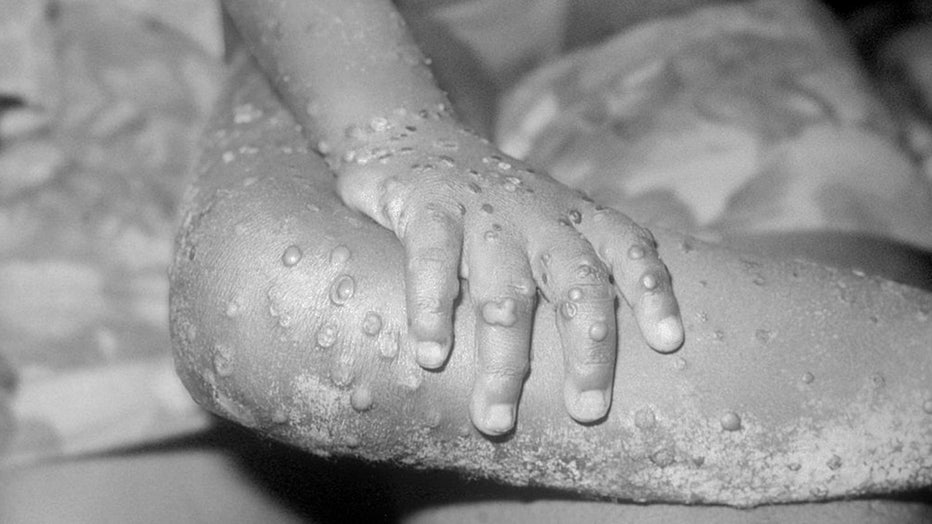Maricopa County confirms 1st probable case of monkeypox in Arizona

Arizona identifies first probable monkeypox case in Maricopa County
Arizona health officials on June 7 confirmed the first probable case of monkeypox in the state. The Maricopa County Department of Public Health and the Arizona Department of Health Services say laboratory testing returned a presumptive positive result. Confirmatory testing is now underway at the CDC.
PHOENIX - Arizona health officials on June 7 confirmed the first probable case of monkeypox in the state. The Maricopa County Department of Public Health and the Arizona Department of Health Services say laboratory testing returned a presumptive positive result. Confirmatory testing is now underway at the CDC.
The patient has been identified as a man in his 30s who is in isolation and recovering. MCDPH and ADHS did not release a location for where in Maricopa County the probable case was reported.
MCDPH officials stated, "Monkeypox is a viral illness that primarily spreads through skin-to-skin contact, although it can also spread through respiratory secretions during prolonged, face-to-face contact. It is endemic in some countries but not the United States, though several countries, including the United States, have seen cases in recent weeks."
MORE: Monkeypox: What you should know as the disease spreads around the world
Monkeypox? What is it?
According to the Centers for Disease Control and Prevention, monkeypox is caused by a virus that is in the same genus of viruses that causes smallpox.
Monkeypox, according to the CDC, was first discovered in 1958, following two outbreaks of a pox-like disease in colonies of monkeys that were kept for research.
The first human case of the disease was recorded in a country now known as the Democratic Republic of Congo in 1970, during a period of intensified effort to eliminate smallpox. Since then, the disease has been reported in people in several central and western African countries. Cases have also been reported in the U.S., as well as a number of Asian, Middle Eastern, and European countries.
RELATED: 9 Monkeypox cases reported in 7 states, CDC says

FILE - The arms and legs of a 4-year-old girl infected with monkeypox. (BSIP/UIG Via Getty Images)
What are the symptoms of monkeypox?
According to CDC's website, it takes usually seven to 14 days from the time of infection for a person to start feeling symptoms of the disease, but the incubation period can also range from five to 21 days. Officials say the illness begins with a fever, followed by:
- Headache
- Muscle aches
- Backache
- Swollen lymph nodes
- Chills
- Exhaustion
One to three days after the fever starts, a rash will begin, often on the face before spreading to other parts of the body.
MCPH says the rash may begin as small, flat, round discolorations that become raised and fluid-filled (clear or pus) before scabbing. These spots and the fluid in them carry the virus that can infect others. Once scabs fall off, the area is no longer infectious. These spots or lesions can appear anywhere on the skin, genitals, or inside the mouth. Most patients with Monkeypox fully recover from the virus without treatment.
"Monkeypox can spread through contact with lesions, scabs, and bodily fluids, so we encourage anyone who develops fever or swollen lymph nodes with a rash to consult a healthcare provider for testing," said Dr. Rebecca Sunenshine, medical director for disease control at MCDPH.
"ADHS is working closely with local health departments throughout Arizona to identify and respond quickly to any potential cases," added Don Herrington, ADHS interim director. "It’s important to note that monkeypox is highly controllable through simple precautions."
Treatment
The CDC says there is no specific treatment approved for monkeypox virus infections, but antivirals developed for use in patients with smallpox may prove beneficial.
Tecovirimat (also known as TPOXX) is approved by the U.S. Food and Drug Administration for adults and pediatric patients. It's available as an oral 200 mg capsule and intravenous formulations.
Cidofovir (also known as Vistide) is approved by the FDA for the treatment of cytomegalovirus (CMV) retinitis in patients with Acquired Immunodeficiency Syndrome (AIDS).
People who should be considered for treatment might include:
- Persons with severe disease (e.g., hemorrhagic disease, confluent lesions, sepsis, encephalitis, or other conditions requiring hospitalization)
- Persons who may be at high risk of severe disease: Persons with immunocompromise (e.g., human immunodeficiency virus/acquired immune deficiency syndrome infection, leukemia, lymphoma, generalized malignancy, solid organ transplantation, therapy with alkylating agents, antimetabolites, radiation, tumor necrosis factor inhibitors, high-dose corticosteroids, being a recipient with hematopoietic stem cell transplant <24 months post-transplant or ≥24 months but with graft-versus-host disease or disease relapse, or having autoimmune disease with immunodeficiency as a clinical component) Pediatric populations, particularly patients younger than 8 years of age Pregnant or breastfeeding women Persons with one or more complications (e.g., secondary bacterial skin infection; gastroenteritis with severe nausea/vomiting, diarrhea, or dehydration; bronchopneumonia; concurrent disease or other comorbidities)
- Persons with immunocompromise (e.g., human immunodeficiency virus/acquired immune deficiency syndrome infection, leukemia, lymphoma, generalized malignancy, solid organ transplantation, therapy with alkylating agents, antimetabolites, radiation, tumor necrosis factor inhibitors, high-dose corticosteroids, being a recipient with hematopoietic stem cell transplant <24 months post-transplant or ≥24 months but with graft-versus-host disease or disease relapse, or having autoimmune disease with immunodeficiency as a clinical component)
- Pediatric populations, particularly patients younger than 8 years of age
- Pregnant or breastfeeding women
- Persons with one or more complications (e.g., secondary bacterial skin infection; gastroenteritis with severe nausea/vomiting, diarrhea, or dehydration; bronchopneumonia; concurrent disease or other comorbidities)
- Persons with monkeypox virus aberrant infections that include its accidental implantation in eyes, mouth, or other anatomical areas where monkeypox virus infection might constitute a special hazard (e.g., the genitals or anus)
If a person has been exposed to monkeypox and is asymptomatic, they may be eligible for post-exposure vaccination.
Prevention
Officials say the best way to prevent the spread of monkeypox and other viruses is to wash your hands after you touch someone, wear a mask in a crowded indoor space, stay home if you're sick with fever or respiratory symptoms and to avoid touching a rash or skin lesions on someone else.
- Avoid contact with animals that could harbor the virus (including animals that are sick or that have been found dead in areas where monkeypox occurs).
- Avoid contact with any materials, such as bedding, that has been in contact with a sick animal.
- Isolate infected patients from others who could be at risk for infection.
- Practice good hand hygiene after contact with infected animals or humans. For example, washing your hands with soap and water or using an alcohol-based hand sanitizer.
- Use personal protective equipment (PPE) when caring for patients.

Maricopa County confirms 1st probable case of monkeypox in Arizona
The patient has been identified as a man in his 30s who is in isolation and recovering. Learn more about the virus, symptoms, and treatment.

More cases of monkeypox reported around the world
According to the World Health Organization, there have been at least 80 confirmed cases in 11 countries.

'Monkeypox' sign and monkeypox illustrative models displayed on a screen are seen in this multiple exposure illustration (Photo by Jakub Porzycki/NurPhoto via Getty Images)

